Davenport Post Office: A century-old business
Davenport Station home | Index to History pages
Davenport History
The Post Office and Stationery shop at 219 Bramhall Lane has has served the residents of Davenport for well over a century. This feature explores its history, and some of its neighbours, as well as some of the people who lived and worked there.
The map is from 1907, with the Post Office marked in red. 223 to 231 are yet to be converted to shops, as the front gardens reveal. Davenport station is at the bottom of the image.
The buildings between 205 and 235 Bramhall Lane, Davenport (or Cale Green some would say) were not built as the shopping area we see today; they were all originally private houses, built in the 1890s on a plot of land which had probably once been owned by the Davenports of Bramall Hall, but by that time part of the estate the owner was the Earl of Dundonald, heir to the Bamford Hesketh family.
These houses were followed, on the remainder of the plot, by the long streets, Winifred and Countess Streets, named after the wife of the Earl. after see our feature 'Who was Winifred'.
The houses were built by the firm William Winbolt, who also built for himself, a pair of larger house, No. 205 and 207, 'Edale', separated from no. 209 by the opening of what became Winifred Road. William Winbolt himself, and his family, were the first residents of No. 207. Another pair of larger houses was constructed at the other end of the row, on the corner of Kennerley Road, nos. 233 and 235. (235 was the home of William Henry Archbutt, head brewer at Bell's brewery, Hempshaw Lane, who sadly died in 1915, aged 54, while serving in Egypt as a Major in the Territorial Army.)
A 1902 directory shows all the houses in the terrace clearly as family homes, but eventually all became shops or bank branches; initially many of the shopkeepers lived 'above the shop', but in later years the upper floors were mostly let as flats or offices to others, or used for storage, the shopkepers living in houses, mostly not too far away.
All the original buildings survive, but have been changed in various ways for their new role, such as combining, and/or extensions into available space to the back or side. Not immediately obvious to passers-by is the fact that the frontages of the two terraces have been connected by a brick infill, which can be detected in the brickwork between 221 and 223, and the small gap at roof height.
Early days at No.219
The residents of No. 219 in 1901 are of some interest: they were Stockport-born Phoebe Taylor (aged 84) and her 47-year-old son Albert. Phoebe was the widow of Samuel Taylor, born in Warburton, Cheshire, who was the last farmer of 61-acre Mile End Farm, which after being sold for development in the 1870s onwards by the Davenport family became the Davenport Park private estate, The Crescent and nearby streets.
The census shows that Samuel and Phoebe had tried their hand at living in the United States for a while, as both their children were born there, in Boston, Massachusetts, in the 1850s. However by 1861 they were back in England, at Orrish Mere Farm in Cheadle (commemorated by the present Orrishmere Road) and by 1871 had taken on Mile End Farm. Samuel died in the 1880s, and by 1891 Phoebe and her daughter were living at 174 Bramhall Lane South. It's likely that they moved to 219 Bramhall Lane when it was new.
Albert Taylor appears to have sought his fortune in South Africa, as when recorded with his mother at 219 Bramhall Lane in 1901 he gives his occupation as 'Transvaal Refugee' - someone who has returned to England to escape the Boer War, possibly having lost his farm to the Boers.
Phoebe died in 1904, and by 1907 no. 219 had become a shop - a draper's shop run (according a street directory) by Edith Jane Stubbs, born Edith Jane Newton in 1881, who in 1903 had married a butcher, George Stubbs. She was one of the nine children of John Newton, who ran a general store converted from three houses in Higher Brinksway, Stockport. Edith had experience of shop work as she had worked as assistant in her father's establishment. She had a child aged 6 by 1911, which makes us wonder if the 1907 directory entry was out-of-date.
We don't know if there was another occupier before the Cowpes arrived in 1909 (see main article).
All the houses in the 209-221 half of the row had become shops by 1909. All were bought by the grocery firm of John Williams and Sons, who had them converted to a row of shops, trading in nos. 209-211 and renting the rest to other shopkeepers, no doubt on the basis that other shops nearby selling non-grocery items would help their own trade. Land Registry records show that postmaster Alfred Victor Cowpe purchased no. 219 from John Williams and Sons in 1920, having run the Post Office there for some years previously.
The 223-235 row remained as houses in 1902, but this was not to last: see our Williams Deacons Bank feature.
The shops over the years
The extracts from Kelly's directories for 1902 - 1934 may not be accurate.
Bramhall Lane, 1902
205 Burslem, Emma
207 Winbolt, William. Builder
209 Bond, George. Gardener
211 Owen, John. Bricksetter
213 Barker, Octo. Bookkeeper
215 Hague, Charles Arthur. Clerk
217 Lees, William. Drysalter
219 Taylor, Phoebe
221 Unsworth, William
223 Ashurst, Harriet
225 Edge, J. Electrician
227 Page, Ellen Ann
229 Brown, John Fenton
231 Marshall, Eliza
233 Bell, James.
235 Archbutt, William Henry
Bramhall Lane 1907
207 [209] Williams, John & Sons, Grocers
213 Smith, John E. Butcher
215 Lysons, E. Confectioner
217 Harding & Hall. Fruiterers
219 Stubbs, Edith Jane. Draper
221 Dawson, Richard. Boot Repairer
223 Ashurst, Harriet.
225 Etchells, S. Stonemason
227 Boase, F G. A.R.C.A.
229 Allen, James.
231 Miller, Mrs
233 Moor, William Thomas
235 Archbutt, William Henry. Brewer
Bramhall Lane, 1910
207 [?209-211] Williams, John & Sons, Grocers
213 Smith, John E. Butcher
215 Lysons, E. Confectioner
217 Fielding, Henry. Fruiterer
219 Cowpe, J W [?A V]. Stationer Draper &c.
221 Dawson, Richard. Boot Repairer
223 Lord and Chamberain. Decorators
225 Etchells, S. Stonemason
227 Bohllen and Co.
229 Allen, James.
231 Miller, Mrs
233 Moor, William Thomas
235 Archbutt, William Henry. Brewer
Bramhall Lane 1934
205 Ringham, Wm. Kenworthy, boot maker
207 Johnson, Edith & Catherine Elizabeth (Misses), drapers
[1938: Wright A. Baker]
209-211 Williams John & Sons Ltd grocers
213 Fay, Madame, hairdresser.
215 Tynan, James Vincent, cycle agent.
217 Fielding Herbert. Fruiterer / Greencrocer.
219 Cowpe Albert Victor, stationer & sub-post office,
221 unknown [1938: Gatley, W. Butcher]
223-225 Bayley, H. boot & shoe dealer.
223 Burgess Elsie (Miss), ladies' hairdresser. ['Maison Elma']
227 Pilgrim, A. E. draper
229-231 Williams Deacon's Bank Limited
233 Austin, Albert. Confectioner
235 Burgons Ltd. grocers & provision dealers
Bramhall Lane 1951
(From electoral register, includes residents but not lock-up shops. Some were in flats above the shops.)
205 Ringham, William Kenworthy & family [boot maker]
207 ?
207a Antrobus, Francis H
213 Heywood, Susan and Thomas [hairdresser]
217 Fielding, Herbert, Amy & Reginald [greencrocer]
219 Grimshaw, George & Evelyn [post office]
221 Barnes, Osborne & Alice
223 Bayley, Roland & Thelma
227 Smith, Harry & Enid
229 (flat over) Macdonnell Kenneth & Norah
233 Turner, Clifford & Doris
Bramhall Lane 1965
(from Telephone directories)
205 Fleming, F A. Boot and shoe retailer
207 ?
209-211 Williams, John & Sons, Grocer
213 Freda (Heywood, Susan). Ladies' Hairdresser
215 Judith, Ladies' Wear
217 ?Michelle Ladies Wear?
219 Post Office
221 Royle (Butchers) Ltd
223 Richards. Hair Stylists
225 Bayley's boot and shoe retailers
227 Smith H.E & E.W Chemist
229-231 Williams Deacons Bank
233 Siddle, Mrs Winifred M. Confectioner
235 Burgons grocers (?)
Bramhall Lane 2016
205 Coral Bookmakers
207 Defra charity shop
209-213 Spar grocery
215 Halo Hairdressing
217 Direct Dry Cleaning
219 Post Office
221 Bowlings Butcher
223-225 Bargain Booze
227 Badged by Davenport, school outfitters
229-231 Royal Bank of Scotland
233 Sun Spot tanning
235 Divine Hair and Beauty
On the Map

Map detail dated 1917. To the rear of 209-221 was the yard of William Winbolt, builder of many houses in the area. The empty space to the south was part of the grounds of Bramall Mount.
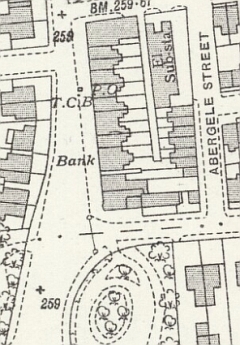
1937: All the front gardens have gone, an electrical sub-station has replaced the builder;s yard, and a Telephone Call Box has been provided outside the Post Office. The green, now owned by the Council, has been landscaped.

1959: Bramhall Lane has been narrowed to provide more area for shoppers and a car park in front of the green. The Telephone box has been moved to a better location, replaced by a Letter Box outside the Post Office. On the corner of Kennerley Road is a 'Police Telephone Pillar' which contained a phone for calling the Police, and a light on the top which would flash if the local policeman was wanted.
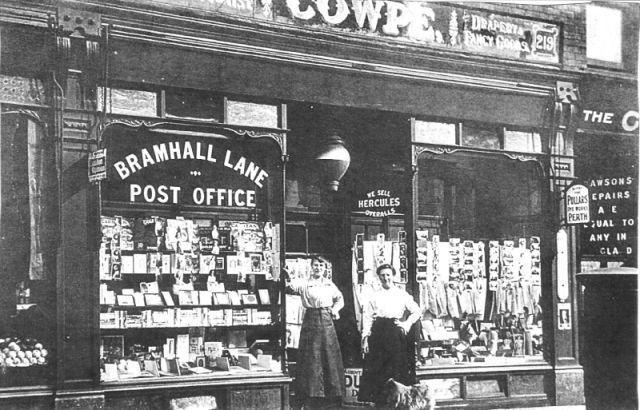
Albert Victor Cowpe was born in Haslingden, Lancashire on 23 May 1979. Albert was the second son of James Cowpe, also a Haslingden native, who was manager of a cotton mill there. Albert married Sarah Ann Taylor, a cotton weaver, of Haslingden in 1909. Soon after their marriage, they came to Davenport and rented the shop and 219 Bramhall Lane as their home and business. The 1911 census describes Albert as a stationer, but he was also sub-postmaster as a 1910 directory shows:
DAVENPORT is a residential suburb of Stockport, Post & M[oney] O[rder] Office. — A. V. Cowpe, sub-postmaster Letter Box. cleared at 8.30 & 11 a.m. & 12.15, 3.15, 5.15, 8 & 8.50 p.m.We don't know the date of the picture above, or why it was taken, although we might assume that the people are Mrs Cowpe and an assistant. The nameboard seems a little faded, so it may not be at the time of opening. It's noticeable that Drapery and Fancy Goods are part of the range, including 'Hercules Overalls', and an agency for Pullar's of Perth, to whom clothing could be sent for dying or dry cleaning. Pullar's had thousands of agents around the UK who would send clothing to Perth by rail. 'Capstan' cigarette advertising can also be spotted in the window, and postcards take up much of the display.
Perhaps it was taken around 1920, when Mrs Cowpe would be aged 40. In that year, Albert Cowpe purchased the shop from John Williams and Sons, subject to a covenant that:
The Purchaser for himself and his executors administrators and assigns hereby covenants with the Company its successors and assigns that he and his heirs executors administrators and assigns will not at any time hereafter carry on upon the hereditaments hereby conveyed or upon any part thereof or permit the same to be used for the purpose of the trade or business of a grocer or provision dealer or any trade or business similar thereto or similar to the business now carried on by the Company at the neighbouring premises numbers 209 and 211 Bramhall Lane aforesaid.This covenant still applies, and is included in the documents relating to its sale in 2015.
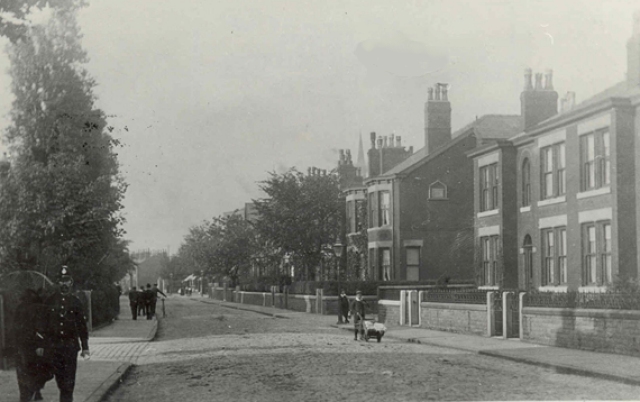
This Bullock Brothers postcard from about 1902 captures the area before these houses underwent any shopping conversions, although there are already shops further along. On the right are the houses which became John Williams and Sons shop, and in 2016 our Spar supermarket. Beyond is No. 207 'Edale' - the name plaque on the side can still be seen today.

This slightly later postcard shows the period scene in peaceful Bramhall Lane, circa 1904, showing the row of shops created by John Williams. The intricate window display of the Post Office, and the pillar box on the pavement outside, can be discerned, as can the large shop of John Williams and Sons at the far end.

This evocative view is from a postcard posted in 1914, but showing the scene several years earlier as the further houses have yet to be altered to shops. John Williams & Sons' ornate frontage on 211-213 is seen to good effect. The 'Pullars of Perth' sign from the heading picture, and the higher nameboard, locate the Post Office. The uniform appearance of the other shops reinforces the fact that they were all converted at the same time on behalf of John Williams & Sons.
By the early 1930s, the Cowpes were still running the post office, and Fielding's still sold fruit, but there had been changes among the other shops. By 1939 the Cowpes had retired to the seaside, at 108 Radcliffe Road, Fleetwood, where they are recorded in the National Register; living with them were two schoolgirls, Sheila Cohen and Kathleen Rose, two of the many children who were evacuated from cities at the start of the Second World War. Their comfortable house, nor far from the sea, still exists: along the opposite side of Radcliffe Road runs the Blackpool and Fleetwood Tramway. In 1939 Albert was described as an 'invalid.' He died in 1954 aged 75, and Sarah died in 1958.
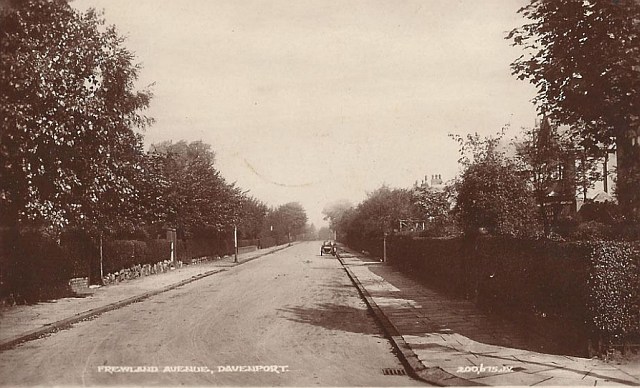
The Cowpes issued their own postcards; the one above, featuring Frewland Avenue, and printed by John Valentine and Sons of Dundee, also bears on the rear the legend 'A.V Cowpe, Post Office, Davenport.' This example was posted in 1943, some years after the Cowpes had left; the number 200,675 dates its publication to 1926 according to a database used by postcard-collecting enthusiasts.
A later sub-postmaster we have been able to trace is Arthur Shirley, born in Stockport in 1887; in 1911 he was living in Countess Street, a short walk from the Post Office, and working as a 'Tailor's Cutter'. He married in 1913 Elizabeth Webb, also born in 1887, and by 1934 the Electoral Register lists them living and working at No. 219; they were still there in 1939. Elizabeth's father lived in Wellington Grove, Stockport and was foreman in a felt hat works. She was working as a 'Tailoress' cutter in 1911, so perhaps they met at work. Both were natives of Stockport, but where they lived between their marriage and when and how they took on the Post Office has so far eluded our research.
The 1951 Electoral Register for No. 219 shows George and Evelyn Grimshaw, who were still there in 1966.

Above is a detail (over-) enlargement from a postcard printed around 1950. The John Williams & Sons grocery at 209 and 211 (see our feature on John Williams) had yet to be expanded to incorporate no. 213. The phone box appears to be the concrete K1 type built in the 1920s, minus its wrought iron roof ornamentation, possibly sent for recycling during the war.
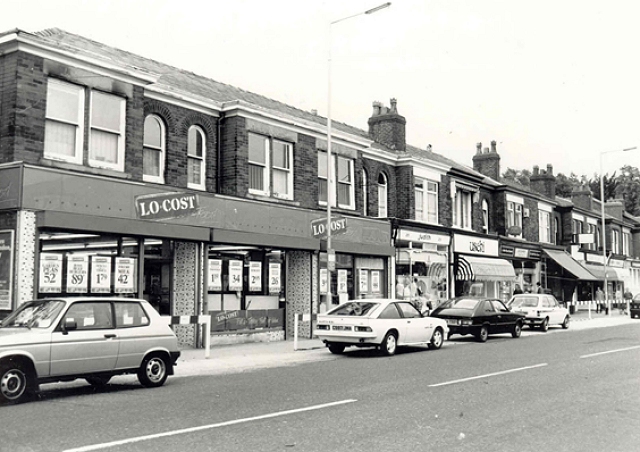
The view above is 1989 in one of a series of pictures taken in 1988-89 by Philip Bradley, capturing Davenport at a time when few cared about recording local history. No. 213 had by then been merged with 209-211. Ladies' outfitters 'Judith' and 'Uschi' are beyond, then the Post Office.
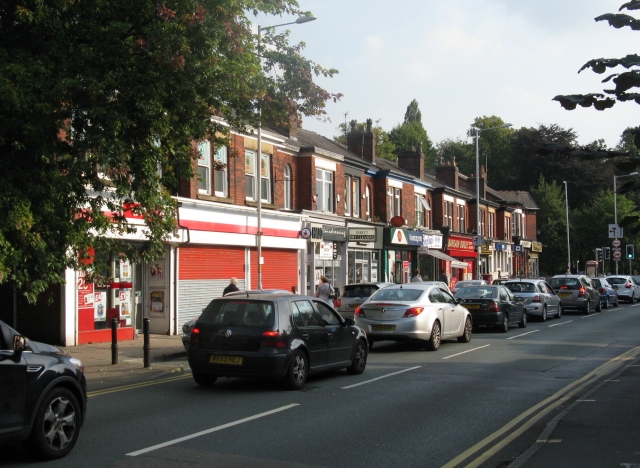
The same view in 2014. Hairdressing and dry cleaning have replaced the two clothes shops.
We'll include here a look at the other shops between 213 and 221.
213 Bramhall Lane had been in 1901 the home of curiously-named Octo Barker, brewer's clerk, his mother Esther and a lodger, Robert Walker, a school art teacher. By 1905 Octo had moved round the corner to 102 Kennerley Road. 213 became the premises of John E. Smith, Butcher, who had re-located from his original shop at 201 Bramhall Lane (see our Ephraim Hallam's Legacy feature) although he continued to live at No. 201 with his wife and son for many years. In the 1930s No. 213 was being used as a ladies' hairdresser, which continued under various names including 'Madame Fay' and 'Freda' (Susan Heywood) until sold for the extension of the John Williams store in the 1960s.
215 Bramhall Lane in 1901 was the home of Charles Arthur Hague, corn salesman, and his extended family. When first turned into a shop, it was rented by Miss Emily Bertha Lysons, confectioner listed in the 1907 directory. She appears there in the 1911 census, aged 41, born in Swinton, Lancashire. She lived on the premises with two female assistants, Winifred Needham (21) and Elsie Antrobus (18) both natives of Poynton, Cheshire.
Emily's father was in the grocery trade, and the 1901 census lists her (surname mis-spelt as Lyons) working as a live-in shop assistant for James Hassall at 25 High Street, Northwich, Cheshire, baker and confectioner. Ten years later she had achieved her own shop, a new one, in Davenport, and was still in business there in the 1920s. She later lived, presumably in retirement, at 7 Chandos Road, Chorlton-cum-Hardy, a comfortable-looking semi-detached house which still exists in 2017; she died at 233 Crescent Road, Crumpsall - Crumpsall Hospital - in Manchester in 1951 aged 81.
In the 1930s 215 was the business premises of James Vincent Tynan (born 1878), a cycle agent' - a bike shop, in modern parlance. James had previously been employed as 'Works Manager, Cycle Tyres' at an India Rubber factory, probably Dunlop's in Manchester, where he would have gained experience of the world of bicycles. He and his wife Eliza Jane Tynan had produced nine children, of which by 1911 only James (aged 7), Vincent (2) and Annie (9 months), were alive, living with them at 25 Ardwick Green, Manchester along with Eliza's mother Harriet Syddall and her brother Thomas Henry Syddall. James Vincent Tynan died in 1934, the year the shop appeared in Kelly's Directory. Eliza Jane retired to the Fylde Coast, where she died in 1969 aged 91.
After the Second World War, in 1945, No. 215 opened its doors as a Ladies' Wear shop called which operated for many years, latterly under the name 'Judith.' When it closed in November 1995, the shopkeeper Pam Lambert told the local press that it had been in the Wakefield Family for 'exactly 50 years' run by her grandmother, her mother, and her aunt Mary Powell who had worked there until her death a few weeks earlier. The shop passed to a new business 'Albata' which sold home-made crafts, with plans to offer a dressmaking service and offer some of the lines previously sold by 'Judith'.
Later it became a florist, and in 2009 the Council refused a planning application to turn it into a pizza shop. Later the same year, an application to make it a café was granted, but it never happened. In 2017 it is home to Halo Hairdressing, established in 2010.
217 Bramhall Lane operated as a Fruiterer, named as 'Harding and Hall' in 1907. In 1910 it was run by Herbert Fielding (born in 1866 in Droylesden, Lancashire). By the following year's census it was operating as a 'lock-up' shop; he was living at their other second shop, 214 Bramhall Lane, one of the pair, then newly-built, near the 'Jolly Sailor' inn. Also living at 214 was his son Ernest and two shop assistants, Amy Hannah Griffiths and Arthur Taylor. His wife Esther had died in 1910.
This was not Herbert's first shop: in 1901 he was selling fruit at 117 Wilmslow Road, Birch-in-Rusholme, Manchester.
By the 1950s the business had passed to the next generation of Fieldings. In later years it became a Ladies' Wear shop, known as 'Michelle' in the 1980s and 'Uschi' in the 1990s. In 2017 it is a branch of the Direct Dry Cleaning chain.
221 Bramhall Lane is the last of the shops created by John Williams and Sons. Its first tenant, whose shop can glimpsed at the right-hand edge of the heading picture, was Richard Dawson, a boot repairer. In 1921 the shop was sold by John Williams to a Samuel Dean Bancroft, probably a landlord rather than a shopkeeper. By the 1930s, and possibly earlier, it was a Butcher's shop. Thomas Frederick Bowling and his wife Sylvia Bowling purchased the business in 1973 and it still trades the name Bowling's in 2017, with its iconic animated model butcher still chopping away in the window.
The story of 223 to 231 Bramhall Lane, developed as shops by The Williams Deacons Bank, is told in our feature about the Bank.
The Post Office over the years
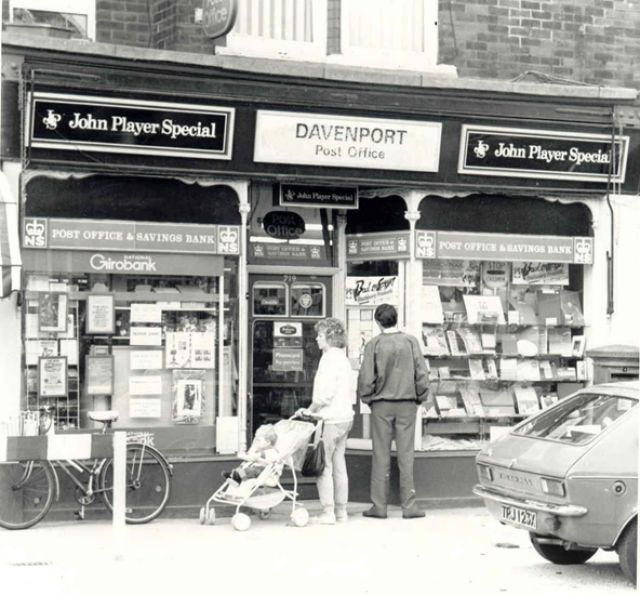
The Post Office frontage had not changed a great deal when photographed by Philip Bradley c.1988, although the nameboard, which must have partially blocked the upstairs windows, had been re-located downwards. The ornate Edwardian window-frames were still in place, and the pillar box was still there, although perhaps in a slightly different position.
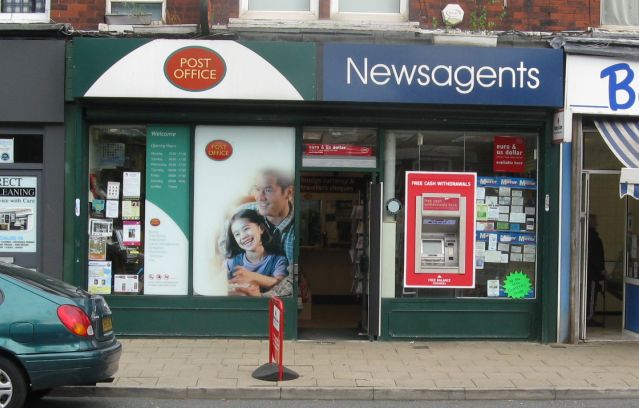
By the time we took this view in 2014 there had been a major facelift to the frontage, and a cash machine had appeared. A copy of the Edwardian picture can be spotted in the window to the left.
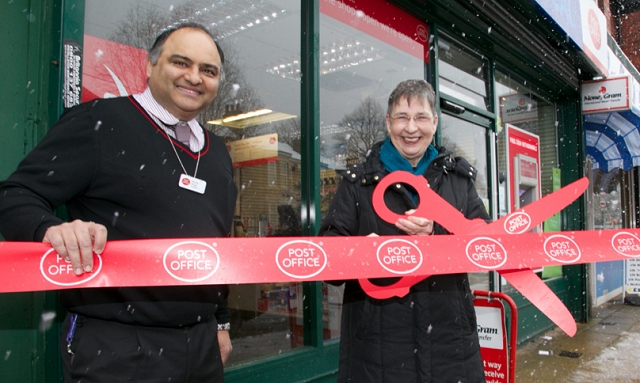
In 2016 the Post Office was re-branded as a 'WH Smith Local' and continued to serve the community on the original site. The picture shows local MP Ann Coffey with sub-postmaster Mandip Athwal celebrating the improvements in March 2016. 'WHSmith Local' was a franchise system, by which retailers paid £4000 per year for the privilege of paying a commission to WH Smith for every product sold including products not suppled by Smith's. Not surpisingly, the scheme didn't last: in 2019 the whole 'Local' project was abandoned, and the shop returned to its former status.
Since 2017 it is the nearest thing we have to a bank, following the closure of the Royal Bank of Scotland branch.
Thanks for help with this feature to the staff of Stockport Local Studies Library, and to Sue Bailey for her father's photographs. The maps are from the National Library of Scotland archive and old-maps.co.uk. Genealogical detail is from ancestry.co.uk, and land ownership from the Land Registry.
Written by Charlie Hulme 2016; last updated March 2021.
Contributions are very welcome at at info@davenportstation.org.uk